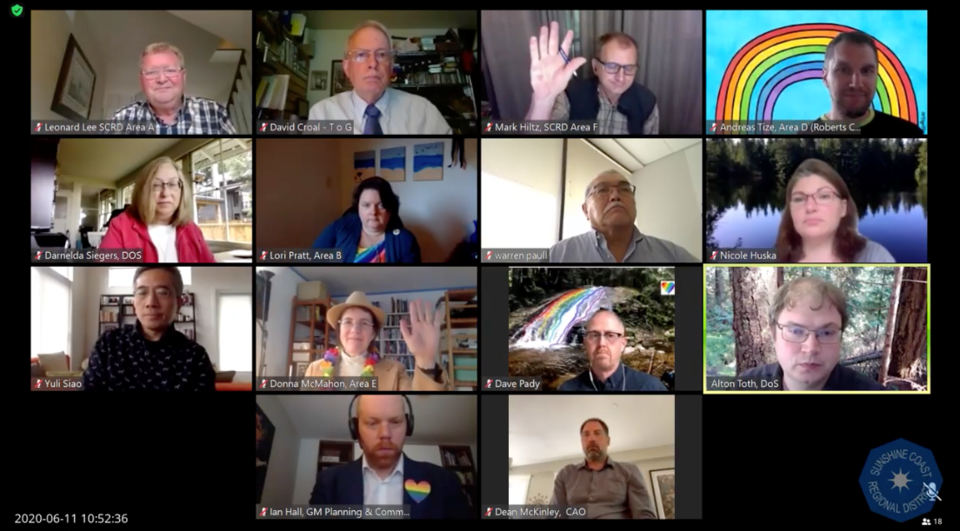Sunshine Coast Regional District (SCRD) directors remain divided over a proposed development in Halfmoon Bay above the highway meant to make it easier to blend business, farming and rural living.
Despite opposition to the proposal from the Halfmoon Bay Advisory Planning Commission, and a recommendation from staff not to proceed, the motion to bring the bylaw amendments to the board for second reading was approved at a June 11 planning committee meeting.
Voting in favour were Halfmoon Bay director and SCRD chair Lori Pratt, Area D director Andreas Tize and Len Lee, director for Pender Harbour/Egmont.
Opposing the application were Elphinstone director Donna McMahon and West Howe Sound director Mark Hiltz.
The 19-hectare property, known as Secret Cove Heights, is located at the end of Stephen’s Way, about 2.5 kilometres north of Highway 101, just south of the turnoff to the Homesite Creek campground. The subdivision would include 15 one-hectare lots. The current parcels form part of a larger subdivision of 64 hectares of private forest.
The area is designated as Resource in the area’s Official Community Plan and zoned as Rural Two (RU2).
The applicant is seeking to change the OCP designation to Rural Residential and add site-specific uses to the RU2 zoning – increasing the number of on-site employees from one to four, allowing home-based businesses and greenhouses as permitted uses, and increasing parcel coverage for buildings to 50 per cent from 15 per cent.
The changes to the bylaws would amount to establishing a “dynamic rural zone” for that specific development.
Despite its intention to create affordable housing and economic opportunities, staff once again spoke against changing the bylaws. “These opportunities are better suited for other locations,” said senior planner Yuli Siao, adding that similar end results could be achieved without resorting to amendments.
A staff report suggested that if approved, the development would “lead to intensification of development in this area, which will have implications on the ecosystem and SCRD’s ability to manage fire protection, flooding, solid waste disposal, land use efficiency and climate resilience.”
In a presentation at the meeting, applicant Nicole Huska urged directors to proceed with second reading and a public hearing, and submitted a 30-page response to the staff analysis, arguing SCRD planners had not “fairly considered the advantages and benefits being proposed, and that staff have been overly rigid in their approach to the innovations that underlie the creation of this new economic zone.”
According to the response, the area is serviced by solid waste collection and is within a fire service area; a “Fire Smart” covenant would be added to each property. It also suggested the location would protect denser hubs from the clamour of farming and “artisanal economic activity” intended for the subdivision.
In the discussion, directors focused on the historical use of the area, and debated whether the location was appropriate for a rural dynamic zone.
Lee spoke in favour of the amendments, saying his visit to the area was an “eye opener.”
“I couldn’t see elsewhere in fact in Pender Harbour or in Halfmoon Bay where the community would be so welcoming … as they are in this development area,” he said.
Pratt acknowledged she was “torn” about the project, given the objections from staff and the APC, but said she wanted to hear additional feedback from the public. “I think we’re in a completely different time and place globally than what we were when the OCP was made and I think we need to look forward,” she said.
Tize also wanted to get the public’s input through a hearing.
Both Hiltz and McMahon remained opposed.
“Especially as chair of the transportation committee, I have a hard time supporting something that creates yet more, 100-per cent car-dependent development,” said McMahon.
She was also skeptical about whether the development would deliver on its vision. “You can zone properties any way you want but you can’t dictate what people will really do on their property,” she said. “I’m not sure that there will be the demand for that sort of rural dynamic activity in such a remote area.”
Hiltz did not see the development as sustainable, and said it disregards the intent of both the current and previous OCP.
“This goes in opposite direction. You put the most people the furthest away from the road,” he said. “I think there’s a lot better places we can try to encourage the growth.”
If second reading is approved at board, a public hearing will be scheduled.



